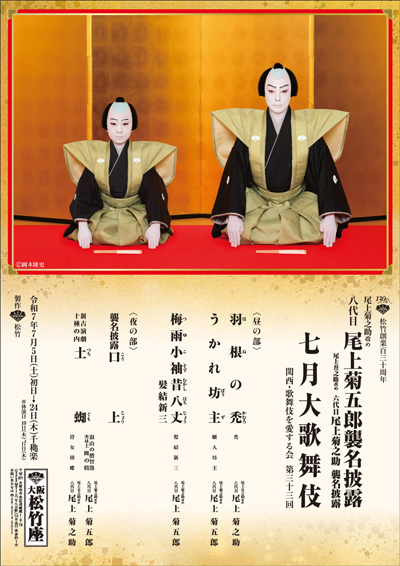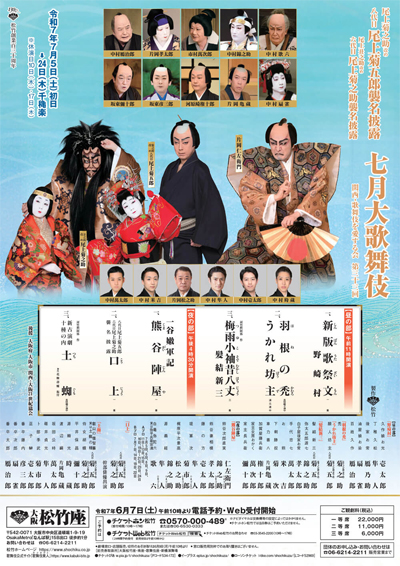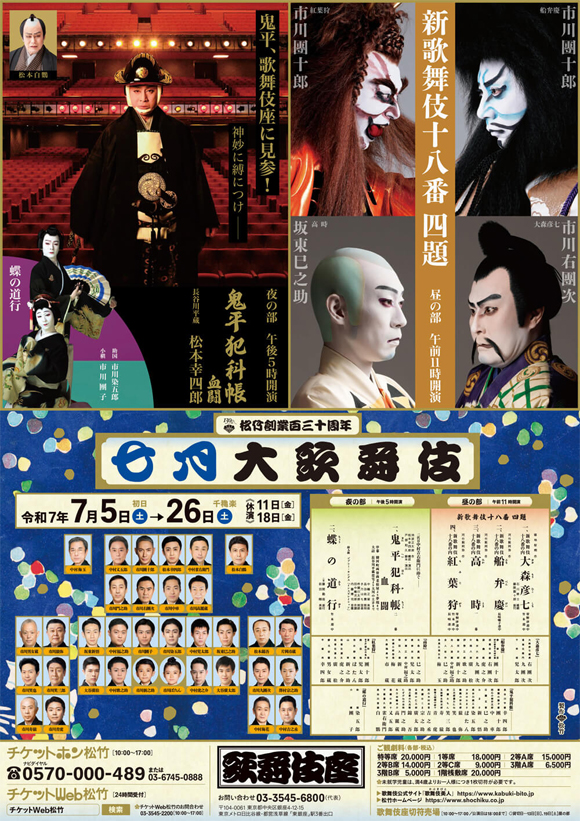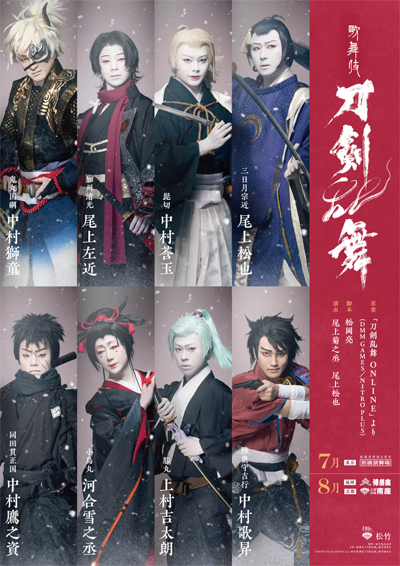| Casting |
Living National Treasure Nakamura Baigyoku, Matsumoto Haku˘, Ichikawa Danjűr˘, Matsumoto K˘shir˘, Nakamura Jakuemon, Ichikawa Udanji, Nakamura Matagor˘, Ichikawa Chűsha, Band˘ Minosuke, Nakamura Kotar˘,
Kataoka Ichiz˘,
Ichikawa Omez˘, Ichikawa Danko, Ichikawa Komaz˘, Ichikawa Monnosuke, Matsumoto Kingo, Ichikawa Kudanji, Ichikawa Emisabur˘, Ichikawa Emiya, Ichikawa En'ya, Ichikawa Juen, Ichikawa Seiko, ďtani Hirotar˘, ďtani Hiromatsu, Band˘ Shingo, Sawamura S˘nosuke, Nakamura Toranosuke, Ichikawa Somegor˘, Nakamura Fukunosuke, Nakamura Utanosuke, Ichikawa Shinnosuke, Ichikawa Shinz˘, Ichikawa Shinjűr˘, Nakamura Baika, Nakamura Kichinoj˘, Ichikawa Botan
|
| Comments |
The usual July Grand Kabuki programs at the Kabukiza.
4 dance-dramas belonging to the Shin Kabuki Jűhachiban are staged in the matinÚe!
ďmori Hikoshichi: this dance-drama is set in the period of the Northern and Southern Courts in the 14th century, the tumultuous era in which two courts existed simultaneously.
The feast to celebrate the great exploits of ďmori Hikoshichi (Ichikawa Udanji), who sided with the Northern court, for defeating Kusunoki Masashige, who sided with the Southern court, is to be held.
Princess Chihaya (Nakamura Kotar˘), the daughter of Kusunoki Masashige, lies in wait in the mountains for Hikoshichi who is making his way to the place.
Funa Benkei: although he won a war against the enemy Heike clan,
the young general Yoshitsune (Nakamura Toranosuke) has gained the disfavor of his brother, the Sh˘gun, and tries to flee to Kyűshű by boat.
Before he sets sail, he must say farewell to his lover Shizuka (Ichikawa Danjűr˘), who performs a dance expressing her grief at their separation.
Once the boat sets sail, the spirit of the great Heike general Tomomori (Ichikawa Danjűr˘),
killed by Yoshitsune in battle at sea, appears and attacks to take revenge for the destruction of his clan.
They are only saved by the prayers of Yoshitsune's companion, the warrior-priest Benkei (Ichikawa Udanji).
The roles of both Shizuka and Tomomori are played by the same actor.
Takatoki: the last H˘j˘ regent in the Kamakura period was arrogant and
given to pleasure and in this play we see him mocked by a band of flying tengu
goblins. First performed in 1884, this is one of the most famous of the
"Living History" plays (katsureki) that replaced the fantasies of Edo Period history plays
with a new attention to historical accuracy. Starring Band˘ Minosuke as Takatoki.
Momijigari: the general Taira Koremochi (Matsumoto K˘shir˘) travels to the mountains to view the
autumn leaves when he suddenly encounters a beautiful princess (Ichikawa Danjűr˘) and her entourage.
Aided by the elegant dancing of the princess and a large amount of sake, Koremochi falls asleep,
not knowing that she is actually a fierce demon. The god of the mountain (Ichikawa Shinnosuke)
dances vigorously to try to wake up Koremochi. But as the demon appears in its true form,
Koremochi is saved by the magical power of his sword.
Onihei Hankach˘ (Kett˘): 'Samurai Detective Onihei' was written by the great author of period novels Ikenami Sh˘tar˘.
It is a masterpiece of period novels in which he portrays the lives of ordinary people with great flair, setting the head of the special police as the hero.
It is early summer in Edo. Hasegawa Heiz˘ (Matsumoto K˘shir˘), who has assumed office as the new Superintendent General of the investigation agency specializing in theft, armed robbery and arson,
is the talk of Kishimojin Shrine. He is feared as 'Heiz˘ the demon' and is nicknamed 'Onihei.' An arrest made by him receives great attention
in Edo. A woman disguised as a street musician who wears a braided hat and carries a shamisen hears rumours of him.
She is Omasa (Band˘ Shingo), the daughter of a bar owner, who loved him when he was young and a libertine called 'Honjo no Tetsu (Tetsusabur˘)'.
She herself has been assisting thieves as her father was formerly a thief, but resolves to quit this. She now offers to be his secret agent,
as she knows that he was appointed the head of the special police. Heiz˘ declines her offer, but she begins to investigate on her own
when she gets information of a vicious crime. Featuring also Matsumoto Haku˘ (Hasegawa Nobuo), Nakamura Jakuemon (Heiz˘'s wife Hisae), Ichikawa Danjűr˘ (Fugen no Shishiz˘),
Band˘ Minosuke (Hioki Genba), Ichikawa Chűsha (Koyanagi Yasugor˘) & Nakamura Matagor˘ (Sagami no Hikojű).
Ch˘ no Michiyuki:
(The Love Suicide of the Butterflies)
When people die, it is said that their spirits become butterflies. Having committed
double suicide, the butterfly spirits of Kond˘ Sukekuni (Ichikawa Somegor˘) and Komaki (Ichikawa Danko)
dance in human form remembering the time they first met and their love for each other.
But their happiness is brief as they are again tormented by hell.
Sources: Earphone Guide Website or Sh˘chiku Kabuki Official Website
|














